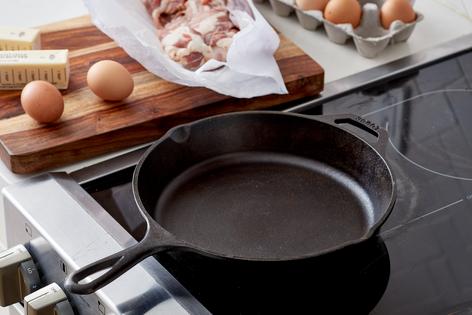The Kitchn: Is cooking with cast iron actually healthier?
There are many benefits to cooking in cast iron. Some of the biggies include more even heat distribution, stovetop-to-oven cooking, and a reliably gorgeous sear. But we’re often told that cast iron cooking has health benefits — is this really true? I’ve operated under this assumption for over a decade, ever since a diagnosis of minor anemia; my doctor reviewed my blood work and suggested that I start cooking meals in cast iron with the idea that the iron in the pan would naturally transfer to the food, which I’d then, of course, eat.
I’ve been cooking in cast iron ever since, but lately I got to wondering: Are the health claims true? Are there real health benefits to cooking in cast iron versus other types of cookware? Or is it all a load of hooey? Let’s take a look.
What exactly is cast iron?
Before we get into the science of it all, let’s define what a cast iron pan actually is.
Cast iron cookware is made from iron (shocking, I know). Most cast iron cookware is made by melting a combination of iron ore and steel at super-high temperatures (we’re talking in the realm of 2,500-3,000 degrees Fahrenheit!). The metals are bonded together and shaped with molds, then typically sandblasted to remove any impurities. These pans are prized because iron is an incredibly dense material — more so than aluminum or copper, for example — and as a result, have great heat-retention qualities.
For the purpose of our discussion today, when we talk about cast iron, we’re talking about the bare variety. This means that food has direct contact with the iron pan, and differs from enameled cast iron, which is lacquered with a food-safe glaze. The glaze makes cleanup easier, and acts as extra nonstick insurance, although, of course, the glaze is not made of iron.
But does that actually matter? Are you gaining health benefits from bare cast iron? Are you losing them when you use enameled cast iron? And why is iron so important, anyway?
Why our bodies need iron and how we get it
Iron is both a material and a mineral. In its mineral form, iron aids in the production of hemoglobin (necessary for red blood cells), as well as hormones. While iron is naturally occurring in many foods, some humans are deficient due to diet, or under-nourishment. Anecdotal evidence here: When I received my anemia diagnosis, I was eating a vegetarian diet and not paying much attention to replacing the iron I would have otherwise been consuming with red meat.
There are two types of iron, heme and non-heme, and both occur naturally in foods. It’s important to note that heme iron, which occurs in animal protein, is more readily bioavailable (processed by our bodies). Non-heme iron relies on other nutrients, namely Vitamin C, to aid in absorption.
So that’s what iron does, and why we need it. How do cast iron pans play into the story?
Cottage cooking lore has us believe that the iron in the pan transfers to the food it cooks, which we then eat. For example, a food naturally low in iron — say, a carrot — could deliver more of the mineral if it picks up the available iron from the cast iron skillet it’s roasted in. Sounds great, right? Well, only if the science is there to back up the theory.
The science behind cast iron mineral transfer
Before we go any further, here’s the brass tacks (iron tacks?): Cooking with cast iron will transfer a small amount of the mineral from the pan to your food to your body. Unfortunately, the amount of mineral transfer is so small, it’s hard to make a case for the skillets and pans as an important source of iron.
Here’s what #science has to say about it: A 2003 study tried to determine whether cast iron food prep could help mitigate anemia in developing countries, but found there to be no conclusive evidence in support of the skillets. Although the study’s authors found promising results, they ultimately concluded that further evidence was needed to make greater claims about the efficacy of cast iron in mineral transfer for anemia. In other words, hemoglobin production did increase in some individuals, but not in a systematic or data-driven, reliable pattern.
There’s another crucial element in iron transfer: The need for an acidic component to strip the pan of its iron! A Korean study completed in 2020 showed that acidic agents were the catalyst to pulling minerals from cast iron cookware. Conversely, the study also revealed that oiling cast iron reduced acid-induced mineral leaching.
So what does this mean? If you’re not cooking with acidic ingredients (and ideally, high heat), you won’t be pulling iron, or any other minerals, from the pan into your food. According to the authors, “the release of toxic metals was highly dependent on pH.” Acidic foods are slightly corrosive, and will “strip” the pan of microscopic layers of its coating. In other words, you’re more likely to absorb a skillet’s iron through a meal cooked in it than you are from licking the pan straight out of the cupboard (which would be weird).
As you may have already guessed, here’s the sticky wicket: If you want your cast iron skillet to be truly nonstick, it won’t transfer much, if any, iron to your food. The very thing that makes a cast iron pan great for searing and sautéing — that oil and fat buildup known as “seasoning” — is what hinders iron transfer. But as a reminder, even if you were cooking everything in vinegar and tomatoes, the acidic stripping would pull negligible amounts of iron from the pan (certainly not enough to see a quantifiable difference in your body’s mineral makeup).
What about other pans?
Cast iron pans aren’t unique in their ability to transfer minerals to the food they cook. A 1992 study showed that stainless steel pans can do the same. The study created an acidic environment in stainless steel cookware (you do the same thing every time you make tomato sauce) and brought it to boiling temperature. The result was that a variety of minerals did seep into the food at a small level. Unfortunately, iron wasn’t the only mineral — nickel and chromium were also absorbed; and these minerals are thought to be harmful to humans. We should note here that once again, the amount of mineral transfer wasn’t large enough to be worrisome. So don’t go hurling your favorite stainless steel saucepan out the window anytime soon.
Ceramic pans, newly beloved by home cooks and chefs, are often touted as being healthier than Teflon-coated nonstick. This is highly debatable, but one thing’s for sure: They won’t transfer naturally occuring minerals to your food due to the coating. (Spoiler alert: Ceramic pans aren’t really ceramic! They’re metal, with a sand-based surface coating. This makes them similar to enameled cast iron.)
And what about that Teflon? Lately it’s been getting a bad rap for potential chemical leaching during cooking. This has been contested, and it’s important to note that any chemical transfer is so small it’s negligible. Kind of like … mineral transfer in cast iron pans.
So, is cooking in cast iron healthier than cooking in other pans?
In short: No.
You’d have to be mouse-sized to see quantifiable health benefits from mineral intake exclusively with cast iron. Because mineral transfer happens at such a small scale, it’s safe to say that cast iron is not any healthier than other pans. It may sear harder and last longer, but it won’t solve your anemia problem.
So why has this story stuck around for so long? Why do we think cast iron is healthier? Well, there’s something intangibly wholesome about cast iron cookware: Their natural materials, rustic appearance and place in literature may make them seem more miraculous than they really are. In a world where we often feel overwhelmed by high-tech, sci-fi appliances, there’s real appeal in a solid hunk of metal that does one thing: cooks your food. Cast iron is great. It always has been. It just won’t cure your health problems.
You can use and love your cast iron skillets. Just be aware that you shouldn’t expect to take in a quantifiable amount of your daily iron requirements through the pan. Remember that the best way to manage a nutritional deficiency is by eating a variety of foods and working with a dietitian to come up with a meal plan that’s tailored to your unique needs.
How to get the most health benefits from your cast iron pans
Although we’d benefit from further research on the efficacy of cast iron pans as an adequate source of iron, there are some steps we can take now to boost their usefulness — even if it’s minor.
1. Use them often. The more you use your cast iron, the more net intake you’ll have of iron. As a bonus, liberal use of your pans makes them better.
2. Don’t be afraid to cook acidic foods. Although we’re often told to avoid cooking high-pH foods in our cast iron pans, if you’re looking for maximum iron intake, acidic ingredients will boost the amount of mineral transfer because of their gentle surface-stripping qualities. Don’t shy away from that shakshuka, for example.
3. Use them to cook foods already high in iron. So, this is a little bit of a cheat. But it’s a smart idea to use your skillet to sear, sauté, and roast foods that have already-high levels of iron. Animal protein, especially red meat, is an obvious choice, but there are many great vegetarian sources of iron as well. Tofu, lentils and chickpeas all have generous amounts of iron and can easily be added to a stir-fry.
(Rochelle Bilow is a senior contributor to TheKitchn.com, a nationally known blog for people who love food and home cooking. Submit any comments or questions to editorial@thekitchn.com.)
©2021 Apartment Therapy. Distributed by Tribune Content AGency, LLC.







